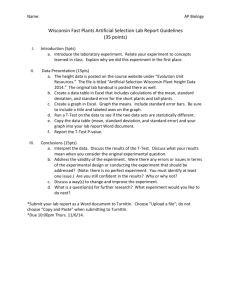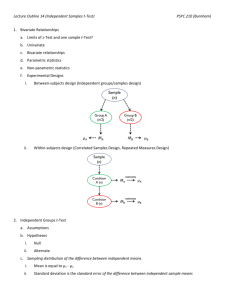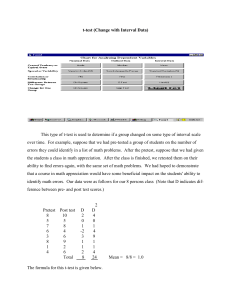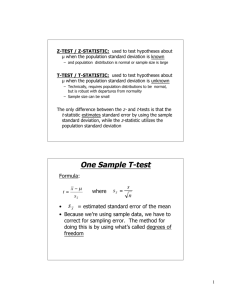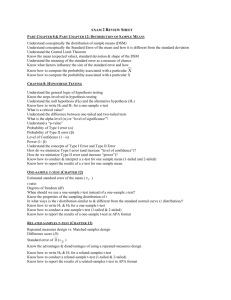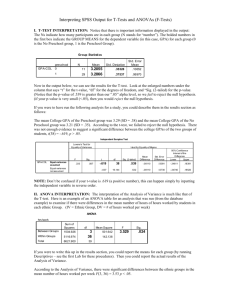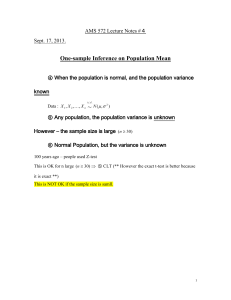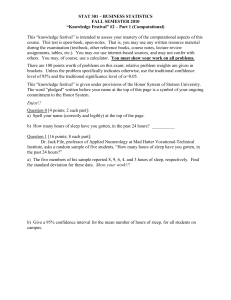Psyc 21621: Quantitative Methods I - Personal.kent.edu
advertisement
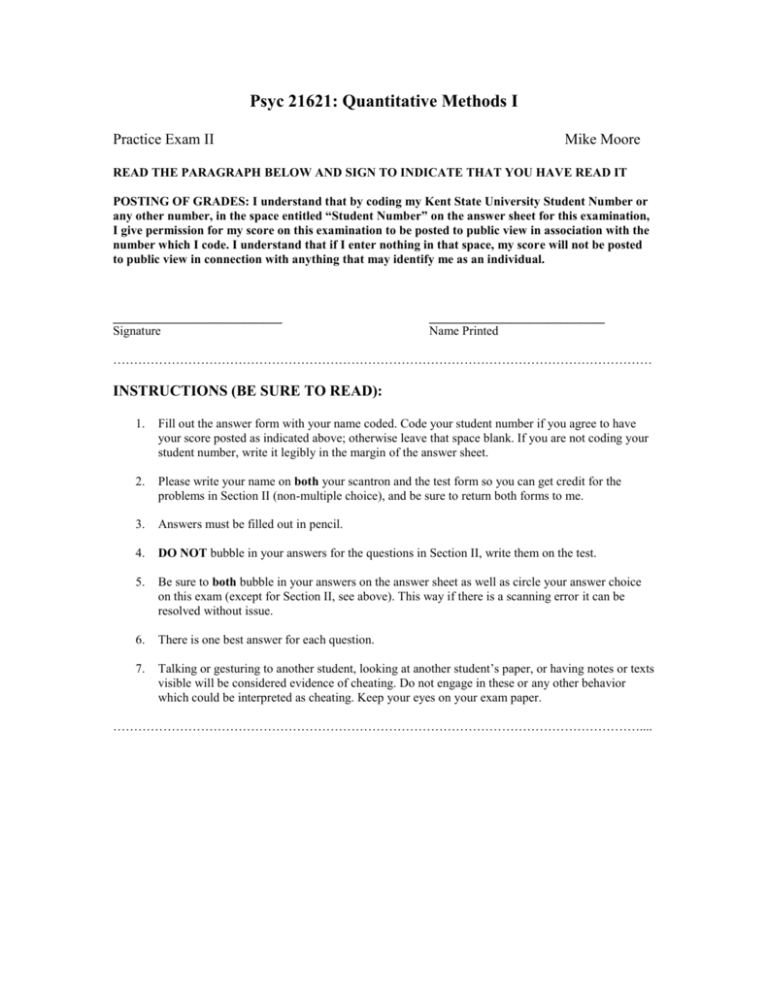
Psyc 21621: Quantitative Methods I Practice Exam II Mike Moore READ THE PARAGRAPH BELOW AND SIGN TO INDICATE THAT YOU HAVE READ IT POSTING OF GRADES: I understand that by coding my Kent State University Student Number or any other number, in the space entitled “Student Number” on the answer sheet for this examination, I give permission for my score on this examination to be posted to public view in association with the number which I code. I understand that if I enter nothing in that space, my score will not be posted to public view in connection with anything that may identify me as an individual. ___________________________ Signature ____________________________ Name Printed ………………………………………………………………………………………………………………… INSTRUCTIONS (BE SURE TO READ): 1. Fill out the answer form with your name coded. Code your student number if you agree to have your score posted as indicated above; otherwise leave that space blank. If you are not coding your student number, write it legibly in the margin of the answer sheet. 2. Please write your name on both your scantron and the test form so you can get credit for the problems in Section II (non-multiple choice), and be sure to return both forms to me. 3. Answers must be filled out in pencil. 4. DO NOT bubble in your answers for the questions in Section II, write them on the test. 5. Be sure to both bubble in your answers on the answer sheet as well as circle your answer choice on this exam (except for Section II, see above). This way if there is a scanning error it can be resolved without issue. 6. There is one best answer for each question. 7. Talking or gesturing to another student, looking at another student’s paper, or having notes or texts visible will be considered evidence of cheating. Do not engage in these or any other behavior which could be interpreted as cheating. Keep your eyes on your exam paper. ……………………………………………………………………………………………………………….... HELPFUL FORMULAS: Mean = X/N XX s2 = N 1 s = √(s2) z X 2 X 2 2 OR t X D0 OR t OR s sD N N 1 n t X n s 2 p n X1 X 2 1 1 s 2p n1 n2 n1 1s12 n2 1s22 n1 n2 2 ……………………………………………………………………………………………................................ Section I: Multiple Choice (Each question is worth 1 point*) *There will be 30 of these on the actual exam. 1. If we were to repeat an experiment a large number of times and calculate a statistic such as the mean for each experiment, the distribution of these statistics would be called a. the distributional distribution b. the error distribution c. the sampling distribution d. the test outcome 2. Sometimes we reject the null hypothesis when it is true. This is referred to as a. a Type I Error b. a Type II Error c. a mistake d. good fortune 3. We would like to a. maximize the power of a test b. minimize the probability of a Type I Error c. do both (a) and (b) d. run tests that never make errors 4. A two-tailed test is _________ powerful than a one-tailed test if the difference is in the direction that we would have predicted a. more b. less c. equally d. we cannot tell 5. If the population from which we sample is normal, the sampling distribution of the mean a. will approach normal for large sample sizes b. will be slightly positively skewed c. will be normal d. will be normal only for small samples 6. The standard error of the mean a. is a function of the number of samples b. is a function of the size of the samples c. is a function of the standard deviation of the population d. both (b) and (c) 7. For a one-sample t-test, the value of t is a. always positive b. positive if the sample mean is too small c. negative whenever the sample standard deviation is negative d. positive if the sample mean is larger than the hypothesized population mean 8. Which of the following does not directly affect the magnitude of t? a. the actual obtained difference ( X - μ) b. the magnitude of the sample variance (s2) c. the sample size (n) d. the population variance (σ2) 9. We are evaluating a method of therapy for extremely underweight adolescent girls. If we weighed our subjects at the beginning and end of therapy, a difference in weight could mean a. that our therapy worked b. that people gain weight over time regardless of what we do c. that our scales changed due to repeated use d. all of the above 10. A repeated-measured t-test is more likely to lead to rejection of the null hypothesis if a. subjects show considerably variability in their change scores b. many subjects show no change c. some subjects change a lot more than others d. the degree of change is consistent across subjects 11. The standard error of the mean of difference scores could be calculated by a. taking the standard deviation of the differences b. repeating the study many times and looking at the distribution of means c. dividing the standard deviation of difference scores by the square root of the sample size d. looking at the standard deviation of the pretest scores 12. If the effect of the first measurement influences what the subject does on the second measurement, we would name this a. a treatment effect b. a carryover effect c. a contaminating influence d. a flaw in the design 13. Which of the following would make you believe that you have two independent groups? a. Subjects were assigned to groups at random as they arrived for testing b. There are 25 subjects in Group 1 and 45 subjects in Group 2 c. Every subject supplies one score d. All of the above 14. When we speak about pooling variances we are referring to a. averaging the two groups’ variances b. using the variance of the larger group c. adding up the variances in each of two groups and dividing by 2 d. taking the variance of both sets of data combined 15. When we have an independent-samples t-test, the degrees of freedom are equal to a. N b. N1 + N2 -1 c. N1 + N2 -2 d. N – 1 16. The normality assumptions behind the independent-samples t-test a. is one that we cannot get around b. diminishes in importance as the variance of the two groups increases c. is absolutely unimportant d. diminishes in importance as the sample sizes increase 17. All other things being equal, one study will have more power than another study if a. it has more subjects b. it controls error variance better c. it compares groups that are more extreme d. all of the above 18. When it comes to estimating the effect size we can use a. prior research b. a statement of what we would expect to find c. special conventions that have been set by others d. all of the above 19. Is it more meaningful to find a significant difference with a relatively small sample size or with a relatively large sample size? a. It points to a more robust difference if you have a small sample size b. It points to a more substantial difference if you have a large sample size c. The two differences are equally substantial d. We can’t tell anything about the size of the effect from what is given here 20. If we have the possibility of different numbers of subjects in each of two groups, we will maximize our power if a. we put most of the subjects in the group we care most about b. we put most of the subjects in the group we care least about c. we equalize the number of subjects in the two groups d. it doesn’t make any difference so long as we maximize the total number of subjects overall Section II: Problems* (Each question is worth 10 points) *Remember to show all (if any) work, partial credit will be given *DO NOT bubble your answers to this section on the scantron *There will be four of these problems on the actual exam 21. The following 10 numbers were drawn from a population. Is it likely that these numbers came from a population with a mean of 13? Evaluate with a two-tailed test at p < .05. 5, 7, 7, 10, 10, 10, 11, 12, 12, 13 a. State both in words, and then symbolically what your H1 and H0 would be. b. What kind of test would you use (i.e. Repeated-Measures t-test, z-test, etc.)? c. What is your df? What is your critical t? d. Based on the above information, would you reject H0, or fail to reject it? Why? How would you state your conclusion in words? e. Compute the 95% confidence limits on μ. 22. A movie critic believes people linger in the theatre after a movie for longer periods following dramas than comedies. Evaluate with a one-tailed test at p < .05. The data follow: Dramas X s2 N 100 sec. 35 sec. 5 Comedies 90 sec. 8 sec. 15 a. State both in words, and then symbolically what your H1 and H0 would be. b. What kind of test would you use (i.e. Repeated-Measures t-test, z-test, etc.)? c.What is your df? What is your critical t? d. Based on the above information, would you reject H0, or fail to reject it? Why? How would you state your conclusion in words? Practice Exam #2: Answer Key 1. 2. 3. 4. 5. 6. 7. 8. 9. 10. 11. 12. 13. 14. 15. 16. 17. 18. 19. 20. 21. C A C B A D D D D D C B D A C D D D A C a. Ho = That the sample mean is not significantly different than the population mean = X ; H1 = That the sample mean is significantly different from the population mean = X b. One-Sample T-Test c. df = 9, Critical t = ±2.262 d. t 9.7 13 -4.04 2.58 10 Because this value of t falls within our rejection region we would reject Ho and conclude that our sample is significantly smaller than the population. e. 7.85 ≤ μ ≤ 11.55 22. a. Ho = that the mean lingering time for the Comedy Group will be greater than or equal to the Drama Group = X D X C ; H1 = that mean lingering time for the Drama Group will be significantly higher than the Comedy Group = X D X C b. Independent-Samples T-Test c. df = 18, Critical t = 1.734 d. t = 100 90 1 1 14 5 15 = 5.18 Because this value of t falls within our rejection region we would reject Ho and conclude that people do linger in the theatre longer after dramas than comedies. Decision Tree For Statistical Tests for Exam II Are you given σ? Yes No Use z-test for means* Do you have one or two samples? One Two Use One-Sample TTest x Are your groups independent? Yes No Use Two-Samples T-Test y Use RepeatedMeasures T-Test z Helpful Formulas: Mean = X/N XX s2 = N 1 X 2 X 2 2 OR xt N N 1 n s = √(s2) s 2p *z n1 1s n2 1s n1 n2 2 2 1 2 2 X s zt D0 sD n X n yt X1 X 2 1 1 s 2p n1 n2



